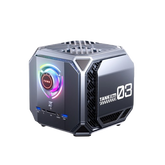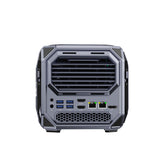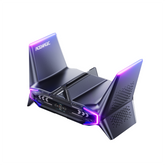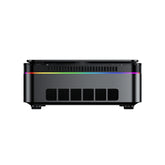GPU vs CPU:What’s the Difference and Which Matters More for Performance?

Modern computers rely on two major components to process information efficiently: the CPU (Central Processing Unit) and the GPU (Graphics Processing Unit). Each plays a distinct role in how systems handle workloads — from opening applications to running complex simulations. Understanding their difference helps users choose the right hardware for gaming, creative work, or AI development.
Both units execute instructions, but in different ways. The CPU focuses on sequential logic, controlling every process within the operating system and software. The GPU specializes in parallel computation, handling thousands of small tasks at the same time. This distinction directly influences speed, power use, and cost efficiency.
When comparing GPU vs CPU, one is not a replacement for the other. They operate as a complementary pair inside every modern system. The CPU directs operations and coordinates data flow, while the GPU accelerates graphical rendering and parallel workloads.
Below is a simplified illustration showing how both components fit into a computer's architecture:
| Component | Primary Role | Example Tasks |
|---|---|---|
| CPU | Manages overall system control | Running operating system, managing files, handling input/output |
| GPU | Executes large-scale parallel calculations | Rendering 3D graphics, accelerating AI models, and encoding video frames |
In this article, you will learn:
- The core structure and functions of both processors
- How performance differs across various applications
- Which component matters more for tasks such as gaming, AI, and video editing
- How CPUs and GPUs cooperate for balanced performance
What Is a CPU (Central Processing Unit)?
The CPU is often referred to as the "central brain" of a computer. It executes the operating system's instructions, manages input and output, and coordinates every active process. Unlike specialized processors, the CPU handles a wide variety of tasks, prioritizing flexibility and precision over raw parallel power.

How CPUs Handle Tasks Sequentially
A CPU executes commands step by step. Each instruction passes through a defined cycle—fetch, decode, execute, and write back. This sequential model allows accurate control and logical consistency, which is crucial for operating systems, data management, and user applications.
Instruction Execution and Logic Operations
Modern CPUs rely on instruction sets such as x86 or ARM. These sets define the binary language that software uses to communicate with hardware. Every action—adding numbers, moving data, or comparing values—runs through these logical operations.
The CPU contains several core units:
- Arithmetic Logic Unit (ALU): Performs mathematical and logical functions.
- Control Unit (CU): Directs data between memory and processing units.
- Registers: Store temporary data and addresses for fast access.
This design prioritizes accuracy, minimal latency, and precise timing over large-scale throughput.
Multi-Core Processing Explained
Early CPUs had a single core, processing one thread at a time. Today's processors integrate multiple cores, each capable of running separate threads. A quad-core CPU can handle four independent tasks simultaneously, improving responsiveness during multitasking or demanding workloads.
However, multi-core efficiency depends on how software distributes work. Applications such as spreadsheets or document editors may gain little from multiple cores, while video rendering or data compression can benefit significantly.
When CPU Performance Matters Most
CPU power becomes critical when tasks require sequential logic or frequent decision-making. Examples include:
- Managing background system operations
- Running databases and spreadsheets
- Handling multitasking in office environments
- Executing single-threaded applications like older games or specific engineering tools
The table below highlights where CPUs outperform GPUs and vice versa:
| Task Type | CPU-Optimized | GPU-Optimized |
|---|---|---|
| Operating system control | ✅ Yes | ❌ No |
| Text processing | ✅ Yes | ❌ No |
| Spreadsheet calculations | ✅ Yes | ❌ No |
| 3D rendering | ❌ No | ✅ Yes |
| Deep learning | ❌ No | ✅ Yes |
| Video encoding | ✅ Partial | ✅ Partial |
The CPU's role remains indispensable. It manages resources, ensures stability, and orchestrates other components, including the GPU.
💡For readers who want to explore CPU architecture in greater depth and understand how cores affect multitasking and speed, check out our detailed guide: What Are CPU Cores?
What Is a GPU (Graphics Processing Unit)?
The GPU, or Graphics Processing Unit, is a specialized processor designed to handle parallel computations efficiently. Its structure allows thousands of small tasks to execute simultaneously, which makes it ideal for rendering images, processing video frames, and accelerating artificial intelligence models.
While the CPU manages overall control, the GPU focuses on massively repetitive mathematical operations. Its design emphasizes throughput over sequential logic, enabling smoother visuals and faster data processing across complex workloads.

How GPU Works Differently from CPU
Unlike CPUs that operate through a few high-performance cores, GPUs include hundreds to thousands of smaller cores. Each core performs lightweight arithmetic operations, but together, they handle large data sets in parallel.
This distinction makes GPUs particularly effective in applications where the same instruction must be applied repeatedly to different data — for example, computing pixel colors in an image or processing neural network layers in AI.
GPUs Feature Thousands of Smaller Cores
A modern GPU, such as NVIDIA's RTX 4090, can contain more than 16,000 CUDA cores, compared with a CPU's 8 or 16 cores. These cores work simultaneously, each performing a simple calculation, contributing to an enormous increase in throughput.
This high parallelism allows GPUs to complete tasks like matrix multiplication or 3D rendering far faster than CPUs, which must process data sequentially.
Why GPUs Excel at Visual and Mathematical Tasks
GPUs use graphics pipelines that divide complex rendering processes into smaller, manageable stages. Each stage performs a specific function—geometry processing, shading, texturing, or rasterization.
Shader units, part of this pipeline, perform mathematical transformations that convert 3D models into the 2D images displayed on screen. These shaders are also used in modern computing to accelerate deep learning and scientific calculations, extending GPU applications beyond graphics.
Common Use Cases for GPU
GPUs are now integral to multiple industries due to their efficiency and scalability.
| Application Area | GPU Role | Performance Benefit |
|---|---|---|
| Gaming | Renders high-resolution graphics in real time | Higher FPS and visual detail |
| 3D Rendering | Calculates light, shadow, and texture in design software | Faster rendering and previews |
| AI and Machine Learning | Accelerates neural network training | Shorter training times |
| Video Editing | Handles real-time playback and effects rendering | Smoother editing workflow |
| Scientific Computing | Runs simulations and data modeling | Increased computation throughput |
The chart below summarizes typical core counts between CPUs and GPUs:
| Processor Type | Average Core Count | Processing Type | Ideal Workload |
|---|---|---|---|
| CPU | 4–16 cores | Sequential | Logic-based, task control |
| GPU | 1,000–16,000+ cores | Parallel | Graphics, AI, rendering |
In short, GPUs excel when speed depends on parallel task execution. Their efficiency transforms not just gaming, but also AI research, data analytics, and video production.
Key Differences Between CPU and GPU
The distinction between a CPU and a GPU lies in how they process information. Both are essential, but their designs serve different goals: the CPU focuses on control and precision, while the GPU maximizes parallel performance. Understanding these structural and performance contrasts helps users choose hardware that fits their workload.

Architecture and Design
At the architectural level, the CPU and GPU follow different philosophies.
| Feature | CPU | GPU |
|---|---|---|
| Core Count | 4–16 cores | Hundreds to thousands of cores |
| Clock Speed | Higher (3–6 GHz) | Lower (1–2 GHz) |
| Core Type | Complex, general-purpose | Simple, specialized |
| Primary Goal | Task coordination, system logic | Parallel data processing |
| Memory Hierarchy | Larger cache, optimized for latency | Wider bandwidth, optimized for throughput |
A CPU uses a few complex cores with large caches, suited for decision-based and sequential operations. In contrast, a GPU relies on many smaller cores that share resources, allowing thousands of simultaneous computations.
This design trade-off reflects their intended roles: CPUs prioritize responsiveness and control, while GPUs target raw parallel efficiency.
Performance and Workload Type
CPU and GPU performance cannot be directly compared by clock speed or core count alone. Their efficiency depends on the workload type.
- CPU excels in single-threaded or low-parallelism tasks such as running system software, managing memory, and executing logic-heavy code.
- GPU excels in tasks that can be divided into many small operations — like rendering graphics or processing tensors in deep learning.
| Workload Type | Best Performer | Reason |
|---|---|---|
| Operating system and logic | CPU | Needs sequential control and quick decision-making |
| Gaming graphics | GPU | Handles millions of pixels and visual effects simultaneously |
| AI training and inference | GPU | Optimized for matrix multiplications and data parallelism |
| Spreadsheet calculations | CPU | Limited parallel gain |
| Video rendering | GPU | Encodes frames in parallel |
| Simulation or modeling | GPU | Handles repeated calculations efficiently |
In practical terms, CPU performance scales with clock speed and core efficiency, while GPU performance scales with core count and memory bandwidth.
Power Efficiency and Heat Output
Power consumption varies significantly. GPUs draw more total power, but they process more data per watt when workloads are parallelized. CPUs, on the other hand, use power more steadily but handle fewer concurrent operations.
| Processor Type | Typical TDP (Thermal Design Power) | Efficiency Focus | Cooling Requirement |
|---|---|---|---|
| CPU | 45–125 W | Consistent control and logic | Air or basic liquid cooling |
| GPU | 150–450 W | High throughput per watt | Advanced liquid or multi-fan cooling |
In data centers, GPUs often require specialized cooling due to their heat output. However, they can outperform CPUs several times over in AI training workloads, making the extra power draw worthwhile for performance-focused systems.
A balanced system often combines a mid-range CPU with a capable GPU, matching cost to workload type. For instance, in gaming PCs, the GPU typically consumes 60–70% of the total build budget because graphical processing dictates frame rate and visual quality.
In essence:
- CPU → precision, control, system management.
- GPU → parallel power, rendering, data acceleration.
Each performs best within its design scope, and performance gains depend on choosing the right processor for the right job.
CPU vs GPU for Different Use Cases
Different applications depend on CPUs and GPUs in distinct ways. Knowing where each processor contributes most helps users build systems that balance cost, performance, and energy efficiency. Below are four common scenarios illustrating how CPU vs GPU performance varies across workloads.

Gaming
Gaming performance depends heavily on the GPU, but the CPU still plays a vital role. The CPU manages game logic, including physics calculations, AI behavior, and input handling, while the GPU renders textures, lighting, and visual effects.
A weak CPU can bottleneck performance even with a strong GPU, especially in CPU-intensive games like Cities: Skylines II or Total War. Conversely, GPU-heavy titles such as Cyberpunk 2077 rely mostly on graphics power.
| Component | Primary Role in Gaming | Example Impact |
|---|---|---|
| CPU | Controls logic, physics, and NPC behavior | Influences the minimum FPS and smoothness |
| GPU | Renders frames, lighting, and textures | Determines visual quality and maximum FPS |
Based on benchmarks from sites such as Technical City, the GeForce RTX 4080 shows around +76% aggregate performance over the GeForce RTX 4060 in some tests. For CPUs, according to a review of the Intel Core i9‑14900K vs Intel Core i5‑14600K, gaming performance gains are in the single-digit percentage range (e.g., ~3%) over the previous generation. Thus, for gaming builds, the GPU should receive a larger share of the budget, provided the CPU meets minimum performance requirements.
AI and Machine Learning
AI workloads depend primarily on the GPU. Training a neural network involves millions of matrix multiplications, a process that fits perfectly with GPU architecture. GPUs can execute these operations across thousands of cores simultaneously, dramatically shortening training times.
For instance, training a ResNet-50 model on an NVIDIA A100 GPU can be 60–80 times faster than on a high-end 16-core CPU. Frameworks such as TensorFlow and PyTorch are optimized to distribute computation to GPUs automatically, using technologies like CUDA or OpenCL.
| Task | Best Hardware | Performance Advantage |
|---|---|---|
| Data preprocessing | CPU | Handles sequential data loading |
| Neural network training | GPU | Parallel computation acceleration |
| Model inference | GPU (for scale) | Efficient batch prediction |
| Light ML tasks | CPU | Lower cost and power usage |
In AI development, CPUs act as coordinators, preparing data and controlling flow, while GPUs perform the heavy computation.
Video Editing and Rendering
Both CPUs and GPUs are important in video production, but their roles differ. The CPU handles encoding, decoding, and file management, while the GPU accelerates real-time previews, effects rendering, and color grading.
Software such as Adobe Premiere Pro, DaVinci Resolve, and Final Cut Pro use GPU acceleration to process effects and transitions faster. For example, GPU rendering can reduce 4K export times by up to 70% compared to CPU-only processing.
| Workflow Stage | Primary Hardware | Notes |
|---|---|---|
| Video decoding | CPU | Processes codec and compression logic |
| Timeline preview | GPU | Renders frames in real time |
| Color correction | GPU | Uses shader cores for grading |
| Final export | CPU + GPU | CPU encodes, GPU accelerates effects |
For creators, a strong GPU is essential for smooth playback and faster exports, while a multi-core CPU supports multitasking and background processing.
Everyday Productivity
For office applications, web browsing, and document editing, the CPU dominates. These workloads rely on responsiveness rather than parallel processing. The GPU contributes minimally, except in systems where integrated graphics handle display output.
| Task | Preferred Processor | Reason |
|---|---|---|
| Word processing | CPU | Logic-driven, low computational load |
| Web browsing | CPU | Dependent on single-thread speed |
| Spreadsheet operations | CPU | Sequential calculations |
| Video playback | GPU (integrated) | Handles decoding efficiently |
A balanced configuration with a 6-core CPU and integrated GPU is often enough for general productivity, consuming less power while maintaining smooth performance.
In summary:
- Gaming: GPU takes the lead.
- AI: GPU dominates computation.
- Video editing: Both contribute; the GPU speeds up rendering.
- Office work: CPU provides all necessary power.
How CPUs and GPUs Work Together
Although CPUs and GPUs serve different purposes, modern computing depends on their collaboration. A computer's performance comes not from either component alone but from how efficiently they share workloads. The CPU handles coordination and control, while the GPU accelerates parallel operations.
The Hybrid Workflow
Every complex task, whether rendering a game scene or training an AI model, follows a coordinated process between the two processors.
- Task Allocation: The CPU breaks down a workload into smaller units. It determines which parts can be parallelized and which require sequential logic.
- Parallel Execution: The GPU receives the intensive parts, such as image rendering or mathematical computation. Thousands of cores work in parallel to process the data rapidly.
- Integration and Output: After the GPU finishes, the results return to the CPU, which integrates them into the final output, whether that's displaying a frame, saving a file, or updating system memory.
This pipeline ensures balanced system utilization. When either component underperforms, bottlenecks appear: CPU-heavy systems cause GPUs to idle, while GPU-heavy setups wait on CPU coordination.
Example
A clear demonstration of CPU-GPU cooperation appears in modern video production software. When editing a 4K video in Adobe Premiere Pro:
- The CPU manages timeline playback, decoding video files, and managing memory allocation.
- The GPU accelerates effects rendering, transitions, and color grading through CUDA or Metal APIs.
During export, the CPU encodes the final file format, while the GPU continues to process real-time effects. If either side falls behind, overall export speed drops, showing that performance depends on both working in tandem.
Similarly, in gaming, the CPU calculates simulation logic and passes geometry data to the GPU, which renders each frame visually. Without strong synchronization, even powerful GPUs produce inconsistent frame pacing or lower minimum FPS.
In short, the CPU orchestrates, and the GPU executes. Together they form a hybrid architecture that balances flexibility with speed—essential for everything from entertainment to data science.
Conclusion
Understanding the relationship between CPU and GPU is essential for choosing the right computing setup. These two processors complement each other—one focuses on control and logic, the other on parallel acceleration. Their combined performance determines how efficiently a system runs across gaming, creative work, AI, and everyday productivity.
The CPU remains the foundation of every computing device. It directs instructions, manages operating systems, and maintains system stability. Its design favors versatility, enabling it to handle varied tasks with consistent precision.
The GPU, on the other hand, has evolved far beyond graphics rendering. With thousands of smaller cores, it delivers massive computational throughput, transforming industries such as machine learning, data analytics, and digital content creation.
In practical terms:
- Gamers benefit most from a strong GPU, provided the CPU avoids bottlenecks.
- Video editors and 3D artists gain from a balanced mix, where the GPU handles effects and the CPU manages encoding.
- AI developers rely heavily on GPU performance, as deep learning models thrive on parallel computation.
- Office users and general consumers get stable performance from efficient CPUs, even with integrated graphics.
A modern computer works best when both units complement one another. The CPU allocates tasks, coordinates timing, and maintains order; the GPU executes massive parallel workloads at scale. Their cooperation defines today's performance standards—fast, responsive, and efficient computing.
FAQ
Which is better, a CPU or a GPU?
Neither is universally better; they serve different purposes. A CPU handles sequential and logic-heavy tasks that require control and accuracy, while a GPU excels at parallel processing for rendering, AI, and data-intensive workloads. The “better” option depends entirely on what you do — for gaming or AI, the GPU leads; for general computing and multitasking, the CPU is essential.
Do I need more CPU or GPU?
It depends on your workload.
- For gaming and 3D rendering, allocate more budget to the GPU.
- For video editing, balance both.
- For AI development, invest mainly in GPU performance.
- For office work or browsing, prioritize a reliable multi-core CPU.
A well-balanced system prevents bottlenecks and ensures stable performance.
Is RAM a GPU or CPU?
Neither. RAM (Random Access Memory) is a separate component that temporarily stores active data and instructions for both the CPU and GPU. The CPU uses system RAM, while dedicated GPUs have their own VRAM (Video RAM) for graphics data. Sufficient RAM capacity helps both processors perform smoothly.
Do you need both a CPU and GPU?
Yes. Every computer requires a CPU to function — it runs the operating system and controls hardware operations. The GPU is optional but crucial for tasks involving graphics, video, or parallel computation. Together, they form a complete and efficient system.
Why do AI systems use GPU instead of CPU?
AI training involves millions of matrix multiplications and repetitive numerical operations. GPUs contain thousands of small cores capable of performing these tasks in parallel, significantly reducing training time. CPUs, designed for sequential control, would take far longer to process the same data volume. This is why frameworks like TensorFlow and PyTorch default to GPU acceleration.








Leave a comment
Please note, comments need to be approved before they are published.